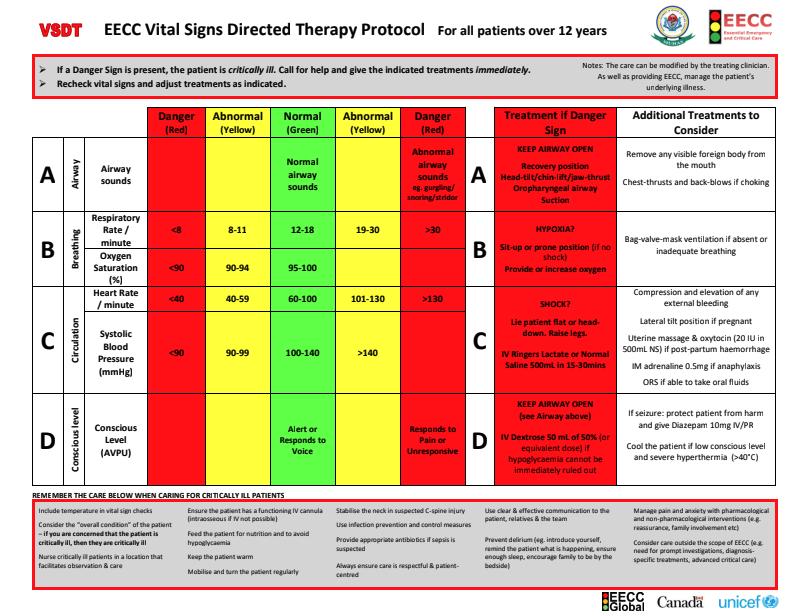
Essential Emergency & Critical Care Tools
EECC Vital Signs Directed Therapy (VSDT) Protocol
The EECC Vital Signs Directed Therapy (VSDT) protocols are one-sided, one-page papers and wall posters that help frontline health workers to identify and treat critically ill patients.
There are two protocols - one for children less than 12 years old and one for patients older than 12 years.
VSDT uses colour codes for a patient’s vital signs (heart rate, blood pressure etc), to indicate if they are normal (green), slightly abnormal (yellow), or severely abnormal (danger sign = red).
If a red danger sign is found, the patient is critically ill and the correct EECC treatments and actions are indicated. The health worker can therefore quickly know when a patient is critically ill and provide the immediately required life-saving care.
The VSDT protocol has been found to be feasible, sustainable and can save lives when implemented in Tanzania here and here
EECC Rapid Health Facility Assessment Tool
Do you want to understand the level of Essential Emergency and Critical Care your health facility delivers?
Part 1 gathers data about Resource Availability & Readiness. Part 2 turns to the EECC care provision currently being carried out.
Resource Availability & Readiness (part 1)
-
1. Fill in information on Page 1
2. Ask the questions on Page 2, circling “Y” for Yes or “N” for No
3. Fill in a point for each “Yes” response in the “Analysis” box
Note some questions have specific instructions for points written in the “Analysis” box
4. Add up points and divide by 25 (the total possible score) and multiply by 100 to get the score in percent
5. Write the Score in the Box on Page 2
-
1. Fill in information on Page 3
2. Observe each item on Page 4. (Must see the item, and if the question requires it, count the items and check if it/they are functioning)
3. Fill in a point for each “Yes” response in the “Analysis” box
Note some questions have specific scoring instructions written in the “Analysis” box
4. Add up points and divide by 28 (the total possible points) and multiply by 100 to get the score in percent
5. Write the Score in the Box on Page 4
6. REPEAT Assessment for each ward/unit in the facility
7. Calculate the facility readiness score by adding up each ward/unit score and dividing by number of wards/units assessed
Evidence based interventions (part 2)
-
1. If time is limited, optional “pre-screening” can be used to first assess which patients are “possibly critically ill” or “definitely not critically ill” using the following approaches:
(a) clinician end-of-the-bed rapid assessment (“eyeballing”) or
(b) asking a nurse which patients are unable to use the bathroom without any form of assistance.
• For the patients who are pre-screened to be “possibly critically ill”, the screening tool is used.
• For the patients who are pre-screened to be “unlikely to be critically ill”, no data are collected.
2. For every patient in the ward/facility, (or if pre-screening used, the “possibly critically ill”), fill in a screening tool
3. Assess if the patient is critically ill (any patient with a severely deranged vital sign or receiving a critical care treatment) – see Annex for age-specific criteria
-
A patient is receiving EECC if he/she is:
critically ill due to the airway criteria and:
lying in the lateral position or
has an oro-pharyngeal or naso-pharyngeal airway or
has an ongoing chin-life or jaw-thrust or
has other airway protection (intubated).
critically ill due to the respiratory criteria and:
is receiving oxygen.
critically ill due to the circulatory criteria and:
is receiving intravenous fluids or
is receiving an intravenous vasopressorion
-
Calculate the score for EECC care provision by summing the critically ill patients who are receiving EECC divided by the total number of critically ill patients in the facility or ward
EECC Resources Checklist
The EECC Resources Checklist is a one-sided, one-page document that lists the equipment, supplies and medicines needed for the provision of EECC. It helps frontline health workers to to check that all essential, life-saving resources are always available and functioning close to the patients’ bedsides every day.
SBAR
SBAR (Situation, Background, Assessment, Recommendation), is a wall poster that reminds health workers about a structured, effective way of communicating information about patients. It can be used when seeking help, at handover or whenever patients are discussed. SBAR enables good communication as a vital part of EECC.




